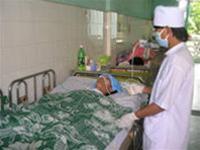Occurrence of drug-resistant tuberculosis
In 2006, a new TB disease appeared in the world - XDR-resistant tuberculosis (XDR). According to the World Health Organization (WHO), tuberculosis is increasing again with a new, more dangerous form due to the HIV / AIDS epidemic.
Survey of the National Tuberculosis Prevention Program, there are about 145,000 more TB patients every year, including 65,000 patients coughing up bacteria. Every day more than 400 people get sick and 55 people die from TB. Particularly in Ho Chi Minh City, Dr. Hoang Thi Quy, Director of Hospital (BV) Pham Ngoc Thach, said the number of TB patients has nearly doubled from 8,000 to 15,000 in the past 10 years. On average, the number of TB patients increases by 2% each year, mainly concentrated in the age group of 25-54 years.
Threatening the community
Dr. Hoang Thi Quy said that resistance is due to incorrect treatment. Normally, the TB treatment process must last for at least 6 months, there are maintenance cases that must be between 12-18 months. But patients often quit treatment after a short time of taking the drug when they see symptoms have been reduced. When the disease comes back, the treatment will be extremely difficult, even ineffective because the TB bacteria have become resistant to the old medicine.

A patient with drug-resistant TB with HIV is being treated at Pham Ngoc Thach Hospital (HCMC).
The danger is that there are new patients who have had TB for the first time, have never been treated for TB, but have developed specific resistance. In patients with secondary drug resistance, resistance occurs after treatment with TB drugs for more than 1 month. And in patients with multidrug-resistant tuberculosis, the cost of treatment is very expensive. This is the reason why the number of people with chronic tuberculosis is increasing but there is no treatment for these patients.
On the side of physicians, the treatment of patients with improper regimens, not providing adequate drugs or providing poor quality drugs, unsupervised treatment . also causes drug resistance. According to Dr. Dinh Ngoc Sy, Chairman of the National Tuberculosis Prevention Program, drug-resistant tuberculosis first appeared as a result of the lack of finance and the health system as well as the weak TB prevention program. . Drug-resistant tuberculosis appears to pose a serious threat to public health, especially in communities with high rates of HIV infection.
Costly treatment, beyond the ability of patients
To combat this drug-resistant tuberculosis epidemic, in Ho Chi Minh City, from 2007-2010, the TB Control Program in Ho Chi Minh City conducted related surveys between drug resistance and the type of tuberculosis and applied TB treatment. drug resistance in accordance with WHO standards.
To limit the proliferation of multidrug-resistant and super-resistant TB germs, Dr. Quy recommends that patients follow the physician's treatment regimen. The general principle in the treatment of multidrug-resistant TB is that patients must take the full dose, regularly and with sufficient time, without giving up treatment. The standard treatment duration lasts from 18-24 months, in which it is mandatory to have a minimum of 6 months of treatment, 6-6 days of treatment with the supervision of the entire treatment period. and monitor monthly tests.
Particularly for people with tuberculosis and HIV, they must be treated for drug-resistant TB four months in advance, then receive further treatment with ARV drugs. For effective treatment of drug-resistant TB patients, only a particularly expensive treatment regimen can be used, beyond the capacity of most patients and the Community Tuberculosis Prevention program.
40% of TB patients in HCMC are resistant to drugs
It is estimated that one third of the population in the world is infected with tuberculosis and every 4 seconds, one person becomes a tuberculosis patient.In which more than 50 million people are infected with drug-resistant tuberculosis and more than 400,000 are multi-resistant TB.Currently, about 32.5% of TB patients are resistant to drugs, in which those who are resistant to many drugs account for a high proportion.HCMC is the locality with the highest rate of drug resistance (nearly 40%).According to a WHO survey, the prevalence of TB resistance in Ho Chi Minh City is three times higher than that of the US, five times that of the UK and 4 times the average rate of the world (9.9%).
BEST
- The risk of occurrence of extremely dangerous resistant TB bacteria in Vietnam
- Bacteria resistant to all drugs discovered in the US
- The world is depleted of new generation antibiotics
- Detecting weaknesses can help kill drug-resistant viruses
- Super TB XDR TB - worrying new plague
- Vitamin D helps TB patients recover faster
- The new method helps shorten the duration of treatment for TB
- Five types of antibiotic-resistant bacteria are particularly dangerous
- US scientists develop new TB diagnostic chip
- New weapons help kill drug-resistant bacteria
- Outbreaks of new viruses resistant to drugs
- New way to diagnose and treat tuberculosis
 Green tea cleans teeth better than mouthwash?
Green tea cleans teeth better than mouthwash? Death kiss: This is why you should not let anyone kiss your baby's lips
Death kiss: This is why you should not let anyone kiss your baby's lips What is salmonellosis?
What is salmonellosis? Caution should be exercised when using aloe vera through eating and drinking
Caution should be exercised when using aloe vera through eating and drinking